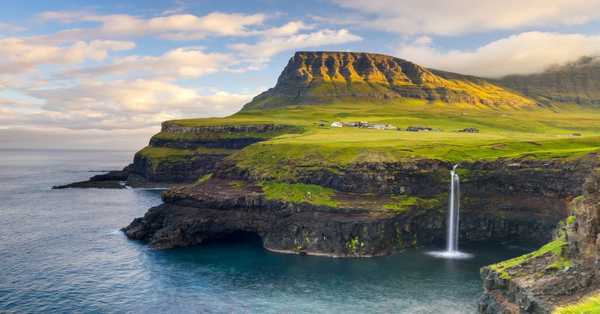You can find about travel advice such as public places & services, best restaurants, activities, sightseen and other key facts of the Faroe Islands, Denmark.
The Faroe Islands, or the Faroes, are a North Atlantic archipelago located 320 kilometres (200 mi) north-northwest of Scotland, and about halfway between Norway and Iceland. Like Greenland, it is a constituent country of the Kingdom of Denmark. The islands have a total area of about 1,400 square kilometres (540 sq mi) with a population of 52,703 as of September 2020.
The terrain is rugged; the climate is subpolar oceanic climate (Cfc)—windy, wet, cloudy, and cool. Temperatures average above freezing throughout the year because of the Gulf Stream. As a result of the moderation and the northerly latitude, summers normally hover around 12 °C (54 °F). Average temperatures are 5 °C (41 °F) in winter. The northerly latitude location also results in perpetual civil twilight during summer nights and very short winter days.
Foods in Faroe Islands :
(1) Skerpikjot
(2) Garnatálg
(3) Seyðahøvd
(4) Grind og Spik
(5) Fish
(6) Seafood
Weather & geography in Faroe Islands :
The Faroe Islands generally have cool summers and mild winters, with a usually overcast sky and frequent fog and strong winds. Although at a high latitude, due to the Gulf Stream their climate is ameliorated. The islands are rugged and rocky with some low peaks; the coasts are mostly bordered by cliffs.
Per day Cost in Faroe Islands :
Prices in the Faroe Islands are comparable to that in Norway. Accommodation prices start from 35 euros per person for a hostel bed and 100 euros for a three-star hotel. Restaurant prices are around 20 euros for a meal and ferries cost around 15 euros return. However, there are ways to keep your budget down.
History of Faroe Islands :
The early details of the history of the Faroe Islands are unclear. It is possible that Brendan, an Irish monk, sailed past the islands during his North Atlantic voyage in the 6th century. He saw an 'Island of Sheep' and a 'Paradise of Birds,' which some say could be the Faroes with its dense bird population and sheep. This does suggest however that other sailors had got there before him, to bring the sheep. Norsemen settled the Faroe Islands in the 9th century or 10th century. The islands were officially converted to Christianity around the year 1000, and became a part of the Kingdom of Norway in 1035. Norwegian rule on the islands continued until 1380, when the islands became part of the dual Denmark–Norway kingdom, under king Olaf II of Denmark.
Following the 1814 Treaty of Kiel that ended the dual Denmark–Norway kingdom, the Faroe Islands remained under the administration of Denmark as a county. During World War II, after Denmark was occupied by Nazi Germany, the British invaded and occupied the Faroe Islands until shortly after the end of the war. Following an independence referendum in 1946 that took place unrecognized by Denmark, the Faroe Islands were in 1948 granted extended self-governance with the Danish Realm with the signing of the Home Rule Act of the Faroe Islands.
Language in Faroe Islands :
Faroese
Danish
Culture of Faroe Islands :
The culture of the Faroe Islands has its roots in the Nordic culture. The Faroe Islands were long isolated from the main cultural phases and movements that swept across parts of Europe. This means that they have maintained a great part of their traditional culture. The language spoken is Faroese. It is one of three insular Scandinavian languages descended from the Old Norse language spoken in Scandinavia in the Viking Age, the others being Icelandic and the extinct Norn, which is thought to have been mutually intelligible with Faroese. Until the 15th century, Faroese had a similar orthography to Icelandic and Norwegian, but after the Reformation in 1538, the ruling Danes outlawed its use in schools, churches and official documents. This maintained a rich spoken tradition, but for 300 years the language was not written down. This means that all poems and stories were handed down orally. These works were split into the following divisions: historical, stories and ballads, often set to music and the mediaeval chain dance. These were eventually written down in the 19th century mostly by Danish scholars.
Things to see in Faroe Islands :
(1) Lake Sorvagsvatn
(2) Mulafossur Waterfall
(3) Saksun village
(4) Vestmanna bird cliffs
(5) Foroya Fornminnissavn museum
(6) Fossa waterfall
(7) Kalsoy island
(8) Mykines island
(9) Kirkjubour
(10) Conquer Slaettaratindur
Hotel in Faroe Islands, Denmark :
(1) Cosy house in the heart of Tórshavn (Á Reyni)
(2) Three bedroom vacation home
(3) Panorama boathouse
(4) Traditional Faroese house in Tórshavns city center
(5) House in the green haven
How to reach in Faroe Islands :
Two airlines fly to the Faroe Islands. These are Atlantic Airways and Scandinavian Airlines. Flights from Reykjavik, Edinburgh and Bergen to the Faroe Islands with Atlantic Airways are only one hour long, and flights from Copenhagen with either Atlantic Airways or Scandinavian Airlines last only two hours.
Travel Guide for Faroe Islands : Food, Cost, Weather & geography, History, language, culture, things to see and do and how to reach. – Published by The Beyond News (Travelling).
